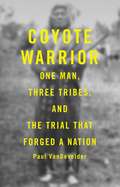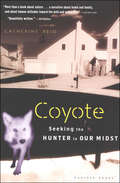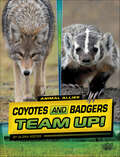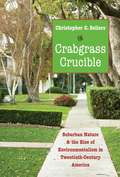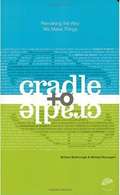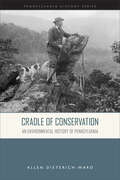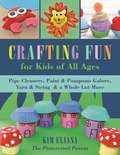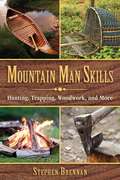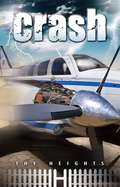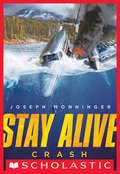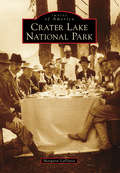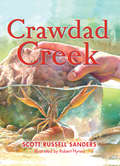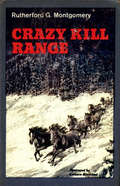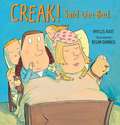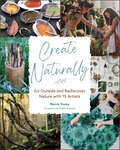- Table View
- List View
Coyote Warrior: One Man, Three Tribes, and the Trial That Forged a Nation
by Paul VandevelerA look at the complex issue of Indian law as it's being molded by a new generation of Native American lawyers, called coyote warriors, who are part of the Indigenous Environmental Network.
Coyote: Seeking the Hunter in Our Midst
by Catherine ReidA &“beautifully written&” tribute to this tenacious and much-misunderstood creature of the wild (Bill McKibben). When Catherine Reid returned to the Berkshires to live after decades away, she became fascinated by another recent arrival: the eastern coyote. This species, which shares some lineage with the wolf, exhibits remarkable adaptability and awe-inspiring survival skills. In fact, coyotes have been spotted in nearly every habitable area available—including urban streets, New York&’s Central Park, and suburban backyards. Settling into an old farmhouse with her partner, Reid felt compelled to learn more about this outlaw animal. Her beautifully grounded memoir interweaves personal and natural history to comment on one of the most dramatic wildlife stories of our time. With great appreciation for this scrappy outsider and the ecological concerns its presence brings to light, Reid suggests that we all need to forge a new relationship with this uncannily intelligent species in our midst. &“More than a book about nature . . . a narrative about home and family, and about human attitudes toward the wild and unfamiliar.&” —The Boston Globe &“A captivating read, worthy of joining the pantheon of literary ecological writing.&” —Booklist &“Enlightening . . . a heartfelt, often poetic case for coexistence between humans and the wild.&” —Publishers Weekly
Coyotes and Badgers Team Up! (Animal Allies)
by Gloria KosterCoyotes and badgers team up to hunt prey in this photo-filled nonfiction resource for young wildlife enthusiasts. One cunning coyote + one burrowing badger = a tremendous twosome! Discover how two vastly different animal species team up for a successful hunt. With sharp senses and speed, coyotes are skilled hunters on their own—except when their prey hides underground. Cue the badgers! These mighty diggers claw into rabbit holes and prairie dog burrows, chasing out the hidden prey. And when they do, this dream team feasts! With eye-popping photographs, quick facts, and beyond-the-book back matter, Coyotes and Badgers Team Up! will have young research writers and wildlife fans rooting for these Animal Allies. Other Animal Allies: Groupers and Moray Eels Team Up! Polar Bears and Arctic Foxes Team Up! Ravens and Wolves Team Up!
Coyotes and Badgers Team Up! (Animal Allies)
by Gloria KosterCoyotes and badgers team up to hunt prey in this photo-filled nonfiction resource for young wildlife enthusiasts. One cunning coyote + one burrowing badger = a tremendous twosome! Discover how two vastly different animal species team up for a successful hunt. With sharp senses and speed, coyotes are skilled hunters on their own—except when their prey hides underground. Cue the badgers! These mighty diggers claw into rabbit holes and prairie dog burrows, chasing out the hidden prey. And when they do, this dream team feasts! With eye-popping photographs, quick facts, and beyond-the-book back matter, Coyotes and Badgers Team Up! will have young research writers and wildlife fans rooting for these Animal Allies. Other Animal Allies: Groupers and Moray Eels Team Up! Polar Bears and Arctic Foxes Team Up! Ravens and Wolves Team Up!
Cozy
by Jan BrettA New York Times Bestseller!A group of clever animals find an unusual but warm and furry home during Alaska's long winter in Jan Brett's newest snowy adventure.Cozy is the softest musk ox in Alaska, with the warmest fur you ever did feel. When a storm hits while he's separated from his family, he starts to feel lonely—but not for long. As the snow piles up, animals start to notice just how warm and cozy Cozy really is! One mama lemming has a bright idea . . . maybe the best place to spend the winter is under Cozy's fur!As more and more animals burrow in, Cozy adds to the house rules: quiet voices, gentle thumping, claws to yourself, no biting, and no pouncing. That seems easy enough . . . until the lemmings, snowshoe hare, snowy owl, arctic fox, and wolverine begin to bicker. Luckily, signs of spring soon appear, and that means Cozy can find his herd and his new friends can head to their summer homes. But not before promising to get cozy with Cozy next year!Jan Brett brings a new lovable character to life through this gorgeous tale of sharing, friendship, and living in harmony. Snuggle up with all of Jan Brett's snowy treasures: The Mitten, The Hat, The Snowy Nap, The Three Snow Bears , and The Trouble With Trolls.
Crab Cake: Turning the Tide Together
by Andrea TsurumiKirkus Best Book / Publishers Weekly Best Book★ "Readers come away with the idea that nourishing and supporting one another is the only way to change the world."–Kirkus, STARRED review★ " [A] wholly original and moving affirmation of one crab&’s power to bring a community together."–Publishers Weekly, STARRED reviewCrab follows his heart in the wake of a disaster and discovers that everyone&’ talents have value when applied with generosity. Feed your craving for a hilarious, heart-warming story with Crab Cake. Humorous, intricate illustrations are perfect to engage readers aged 3-7 while teaching gentle lessons of civic engagement and rallying together as a community. Under the sea, fish do what fish do: Seahorse hides, Pufferfish puffs up, Parrotfish crunches coral, and Crab . . . bakes cakes? Scallop swims, Dolphin blows bubbles, and . . . Crab bakes cakes. And so life goes on, until one night when everything changes with a splash! In the face of total disaster, can Crab's small, brave act help the community come together and carry on?
Crabgrass Crucible
by Christopher C. SellersAlthough suburb-building created major environmental problems, Christopher Sellers demonstrates that the environmental movement originated within suburbs--not just in response to unchecked urban sprawl. Drawn to the countryside as early as the late nineteenth century, new suburbanites turned to taming the wildness of their surroundings. They cultivated a fondness for the natural world around them, and in the decades that followed, they became sensitized to potential threats. Sellers shows how the philosophy, science, and emotions that catalyzed the environmental movement sprang directly from suburbanites' lives and their ideas about nature, as well as the unique ecology of the neighborhoods in which they dwelt. Sellers focuses on the spreading edges of New York and Los Angeles over the middle of the twentieth century to create an intimate portrait of what it was like to live amid suburban nature. As suburbanites learned about their land, became aware of pollution, and saw the forests shrinking around them, the vulnerability of both their bodies and their homes became apparent. Worries crossed lines of class and race and necessitated new ways of thinking and acting, Sellers argues, concluding that suburb-dwellers, through the knowledge and politics they forged, deserve much of the credit for inventing modern environmentalism.
Crabs (Nature's Children)
by Jen GreenHow many different kinds of crabs are there? What do crabs eat? Do all crabs live in the ocean? How big are giant spider crabs? Find the answers to these questions, and learn much more about the physical characteristics, behavior, habitat, and lives of crabs.
Cracking Up: A Story About Erosion (Science Works)
by Jacqui Bailey Matthew LillyDescribes the process of erosion, how weather and water wear away the earth's surface, and what happens to the materials that are worn away.
Cradle To Cradle: Remaking The Way We Make Things
by William Mcdonough Michael BraungartA manifesto for a radically different philosophy and practice of manufacture and environmentalism "Reduce, reuse, recycle" urge environmentalists; in other words, do more with less in order to minimize damage. As William McDonough and Michael Braungart argue in their provocative, visionary book, however, this approach perpetuates a one-way, "cradle to grave" manufacturing model that dates to the Industrial Revolution and casts off as much as 90 percent of the materials it uses as waste, much of it toxic. Why not challenge the notion that human industry must inevitably damage the natural world, they ask. In fact, why not take nature itself as our model? A tree produces thousands of blossoms in order to create another tree, yet we do not consider its abundance wasteful but safe, beautiful, and highly effective; hence, "waste equals food" is the first principle the book sets forth. Products might be designed so that, after their useful life, they provide nourishment for something new-either as "biological nutrients" that safely re-enter the environment or as "technical nutrients" that circulate within closed-loop industrial cycles, without being "downcycled" into low-grade uses (as most "recyclables" now are). Elaborating their principles from experience (re)designing everything from carpeting to corporate campuses, the authors make an exciting and viable case for change.
Cradle of Conservation: An Environmental History of Pennsylvania (Pennsylvania History)
by Allen Dieterich-WardFrom the origins of “Penn’s Woods” to the controversial practice of fracking, Cradle of Conservation provides the first comprehensive study of Pennsylvania’s environmental history. The story starts with forester Ralph Brock at the dawn of the conservation era and continues through the eras of energy production using coal, oil, natural gas, and other resources. Allen Dieterich-Ward also investigates how the non-human world shapes the history of the commonwealth and examines the impact of pollution. Cradle of Conservation moves across time and place, from the Haudenosaunee people of the Susquehanna Valley, to the iron furnaces of nineteenth-century Pittsburgh, to the diesel trucks on the twentieth-century Pennsylvania Turnpike. In addition, Dieterich-Ward explores the histories of Philadelphia’s Schuylkill River and the state’s anthracite region and traces the environmental movements and crises that have led to public policy changes in the face of climate change. Cradle of Conservation deepens our understanding of how Pennsylvanians have conserved and consumed.
Crafting Fun for Kids of All Ages: Pipe Cleaners, Paint & Pom-Poms Galore, Yarn & String & a Whole Lot More
by Kim UlianaIn Crafting Fun for Kids of All Ages, blogger Kim Uliana offers 200 entertaining, versatile, and easy-to-assemble arts and crafts projects for any occasion. Make glittery snowflakes and thumbprint ornaments during the holidays, create straw hats and button sunflowers for summer vacation, or decorate personalized bookmarks for back-to-school.Kim guides readers through each project, giving step-by-step instructions even the youngest crafter will be able to follow. Projects are organized by materials to provide easy searching and shopping for children and adults.Learn how to turn everyday crafting materials into pieces of art with Crafting Fun for Kids of All Ages. Pipe cleaners will become dream catchers and tiaras; buttons will turn into necklaces and wind chimes; tissue paper will transform into princess hats and fire-breathing dragons. Activities include:Crafting with clayPainting processes and ideasFun with pipe cleanersCreative construction paperButtonsAnd a whole lot more!
Crafting Modern Florals: Creating Botanical Patterns with Petals, Pencils & Paint
by Hanna WendelboA creative guide to painting and drawing with flowers! In Crafting Modern Florals, designer Hanna Wendelbo shares her experience in botanical artistry and offers a variety of floral design techniques using florae, watercolor, ink, and more. Capture the unique beauty of each flower with crafts for binding flowers and leaves into patterns and painting and drawing striking floral patterns. Celebrate the beauty of flowers and make your own collection of: StationaryWrapping paperWallpaperAnd so much more! Discover the key to creating beautiful botanical patterns with Crafting Modern Florals.
Crafting with Flowers: Pressed Flower Decorations, Herbariums, and Gifts for Every Season
by Katie MeadowMake Your Own Unique, Whimsical Gifts and Treats Inspired by Nature's Beauty! Everyone could add a bit of brightness to their daily life. This book will teach you how to make a wide range of floral crafts, and help you truly connect to nature and the magical woodlands. The crafts are organized seasonally, so you can happily craft all year round and always have gifts at the ready. Beginning with lovely spring crafts using bright, beautiful flowers, summer crafts aimed more at weddings, celebrations, and festivals, such as dried flower button holes and pressed flower nail art. In autumn we move to more cozy self‑care crafts like bath salts and candles, and winter includes crafts that are handmade gift ideas such as pressed flower cards and ornaments. Crafts include: Crystallized edible flowers to top cakes and cupcakesBotanical wax sachets to keep your closet freshly scentedPink rose petal bath bombsBeautiful botanical framesFlower-infused cookies and chocolates
Crafting with Herbs: Do-It-Yourself Botanical Decor, Beauty Products, Kitchen Essentials, and More
by Debbie WolfeCapture the beauty, fragrance, and power of herbs in these delightful crafts for home and garden. Why craft with herbs? They're easy to grow, beautiful, fragrant, full of health benefits, and are incredibly versatile! Herbs are best known for their medicinal and culinary uses, but there&’s so much more you can do with them. From spray disinfectants to wreaths and garlands, custom herb salts to homemade skincare products, there's something here for every room of your house—and everyone on your gift list! Learn how to make beautiful and useful items such as:Smudge SticksHerb SachetsHanging Herbal SwagNatural ConfettiHerbal Cleaning VinegarsHerb salts (with recipes for different blends)Herbal Teas Compound Herb ButterLavender Neck WrapSimple Herbal BalmAnd much more!In addition to the crafts, learn how to grow, prune, harvest, dry, and store your favorite herbs. Woven throughout are helpful tidbits on the wellness properties and history of herbs.Create useful crafts that will beautify your home and make wonderful DIY gifts!
Crafts and Skills of the Mountain Men
by Stephen BrennanCrafts and Skills of the Mountain Man is a fascinating, practical guide to the skills that have made the mountain men famous worldwide as outdoorsmen and craftsmen. Readers can replicate outdoor living by trying a hand at making rafts and canoes, constructing tools, and living off the land.Learn key skills like:Building a strong fire.Learning to hunt and butcher your meals.Creating a safe and solid shelter.And much more!Whether you're an avid outdoorsman or a novice hiker, Crafts and Skills of the Mountain Man is your handbook to not only surviving outdoors, but flourishing. The style of the mountain man is unique and popular, especially among young people, historians, and those with a special interest in living off the land. The mountain man has been successful outdoors for ages, and now you can too with the skills, tips, and tricks included in this handy manual.
Crafts by the Sea: More Than 30 Creative Projects for Your Beach House
by Larissa CostelloDo you love to be by the coast, walks along the beach, fishing in the sea, or hiking through the cliffs? Collecting shells, trinkets, and other items along the beach is one of the greatest ways to remember the fun you had. This coastal-themed craft book includes a variety of projects for anyone who wants to turn their collections into beautiful keepsakes. In Crafts by the Sea, Larissa Costello guides you through more than thirty crafts that are sure to delight any beach lover. Costello’s easy to follow step-by-step instructions, tips, and examples will help you produce beautiful creations that will make you feel like you are always by the sea. Fun projects featured include:Candle-lit Table RunnerBeach in a BottleClassic ChimesRelaxing Sea Star StringsSandy DishesCoastal Adventure Charms Every craft in this book incorporates the natural resources that you can find by the sea. Ranging from classic sea shell frames and wind chimes, to the popular modern comebacks of string art, and even giving rustic driftwood some extra flair, there are crafts for every style. Now that you have something to do with that shell collection, let’s get to the beach!
Cranky Uncle vs. Climate Change: How to Understand and Respond to Climate Science Deniers
by John CookIt&’s Not Just the Facts When it comes to climate change, this truly is a golden age—of fake news, post-truths, pluralistic ignorance, conspiracy theories, a willfully ignorant administration, and the Cranky Uncle. You know him. We all have one. That exasperating Thanksgiving blusterer digs in his heels even as the foundation of his denial thaws faster than the Arctic ice caps. Written and illustrated by Dr. John Cook, cognitive psychologist and founder of the award-winning website Skeptical Science, Cranky Uncle combines humor and science to make clear, calm, and winnable arguments in the public controversy of climate change. Can we change our Cranky Uncle&’s mind? Probably, regrettably, not. But Dr. Cook makes it easier for us to understand him. And armed with this knowledge, prevent climate misinformation from spreading further.
Crash (The Heights series)
by Ed Hansen Mary Kate DomanThese traditional reads are brimming with spirited characters and positive values--but with a little extra excitement and bite, so hold on to your hats! Written expressly for the middle grade struggling reader, the series does not contain strong language, edgy themes, or dysfunctional families. In fact, family is the main theme of these titles. And one particular Latino family is the focus with their uncanny knack for finding humor, hope, and colorful personalities--even in unusual circumstances. Written at the lowest reading levels, the 50-page story structure is straightforward and moves the reader through the text quickly and efficiently. Lightning lit the sky. The thunder was loud. The light went out. The plane went dark. Then the plane fell.
Crash: Crash (Stay Alive #1)
by Joseph MonningerStranded in the middle of nowhere, you have to fight to survive!When the members of Junior Action News Team crash land in the Alaskan backwoods, one thing is clear: not everyone is going to survive. No cell phones. No internet. Their supplies are limited, as is their knowledge of the wilderness. Part of the group wants to wait it out. Other wants to search for help. But above all they must stay alive!
Crater Lake National Park
by Margaret LaplanteFor more than half a million years, volcano Mount Mazama towered over southern Oregon. From time to time, it erupted, spreading pumice, ash, and cinders for miles around. Then, approximately 7,700 years ago, Mount Mazama erupted with such force that the volcano could no longer support itself and it collapsed, leaving a large caldera. Eventually, the volcanic action subsided and all was calm. Over the next centuries, water and snow accumulated in the caldera. In 1902, Crater Lake became a national park.
Crawdad Creek
by Scott Russell Sanders Robert HynesThere’s always something happening at Crawdad Creek. That’s what Lizzie and Michael call the stream that runs behind their house. Come pan for gold, hunt for fossils, find an arrowhead in the mud or a crayfish under a stone. Watch whirligig beetles and water striders skate across the water, teasing the fish below, and count the turtles sunning themselves on moss-covered logs. Follow tracks along the bank, then sit in quiet amazement as deer, raccoons, and other animals visit the creek. There’s a wild and beautiful world here waiting to be discovered. Take the time to look!
Crazy Kill Range
by Rutherford MontgomeryA black colt, born on a high plateau after his mother is stolen from a ranch, survives the dangers of life on the range to grow into a range stallion and leader of his own herd.
Creak! Said the Bed
by Phyllis RootIT'S THE MIDDLE OF THE NIGHT. Everyone is cozy and tucked up in bed when out of the darkness, SQUEAK, says the door. Mama's eyes fly open. Who's out of bed? Is it Evie? Ivy? Little Mo? On this stormy night in their little house, only Papa keeps snoring away -- Snurfle, Snark -- unaware of the wild weather outside and the growing number of nervous bedmates inside. Will anything wake Papa? CREAK, said the bed. A preposterous series of events takes readers barreling toward bedlam in this delicious read-aloud.
Create Naturally: Go Outside and Rediscover Nature with 15 Artists
by Marcia Young15 makers present personal stories of how nature inspires and enhances their creativityFor artists and crafters of all levels who look for inspiration in natureStories and projects help you find ways to connect to nature with your own works
